Two of the most dangerous spiders you may encounter are the brown recluse and the black widow. Knowing what they look like, how to tell them apart, and how to get rid of them, can reduce the risk of a bite.
Both are considered medically significant and if bitten, you will want to seek immediate medical attention.
Table of Contents
What Are Brown Recluse Spiders
Brown recluse spiders belong to the Sicariidae family and have necrotic venom.
The brown recluse can grow to 0.79 inches (20mm) in body length and are a light to medium color brown.
The cephalothorax (head space) and abdomen may not be the same shade of brown. There is a marking on the top of the cephalothorax that looks like a violin with the neck of the violin pointing towards the back of the spider.
These spiders are often referred to as violin spiders. The violin marking is known to darken as the spider gets older.
The brown recluse is not the only spider with this violin marking, therefore it is best to identify them by looking at the eyes. Unlike other spiders, this spider only has six eyes, which are arranged in pairs. The eyes comprise one median pair and two lateral pairs.
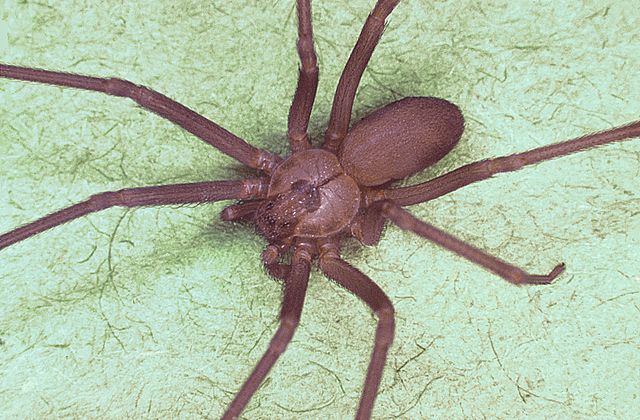
There are no patterns or banding on the body or legs, though there are some spines on the legs. Their abdomen has short hair.
Brown recluse spiders can be found from southeastern Nebraska to southern Iowa, southwestern Ohio, and Indiana. They are also common in central Texas, Kentucky, and Georgia.
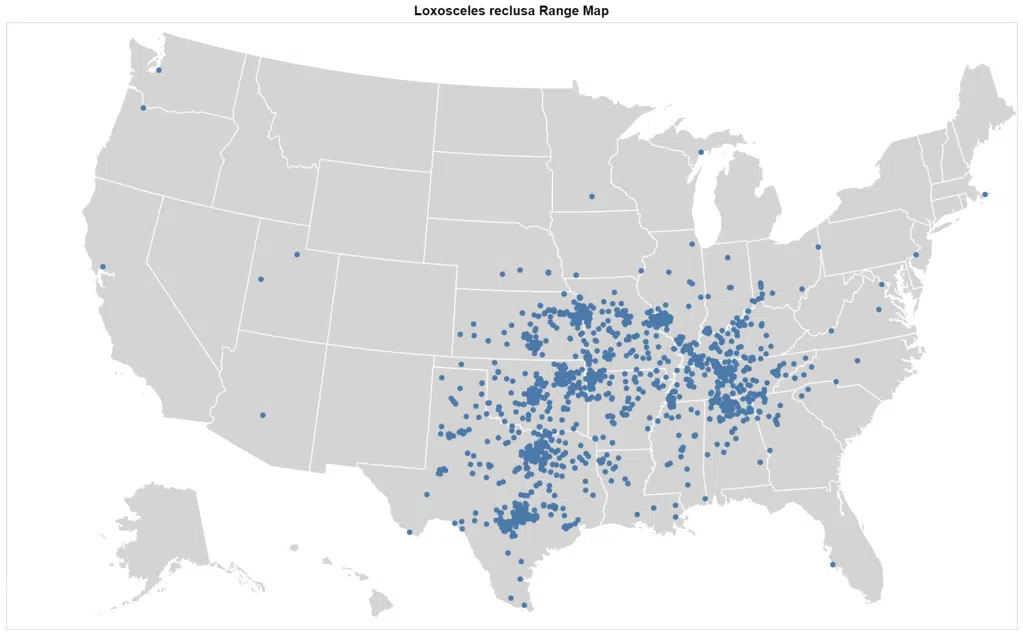
What Are Black Widow Spiders
There are three species of black widow spiders that can be found in the United States, these include:
Southern black widow
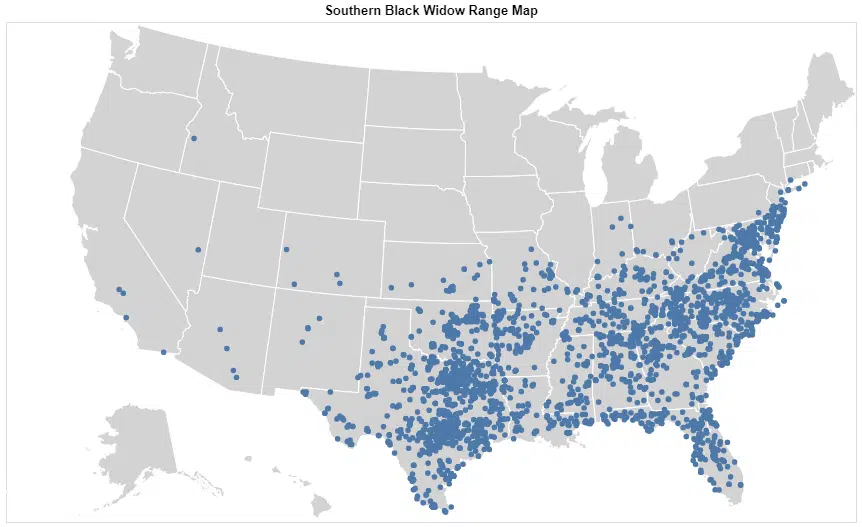
The southern black widow (Latrodectus Mactans) can be found in the southeastern regions of the United States, though they have also been encountered in Texas and Ohio.
Western black widow
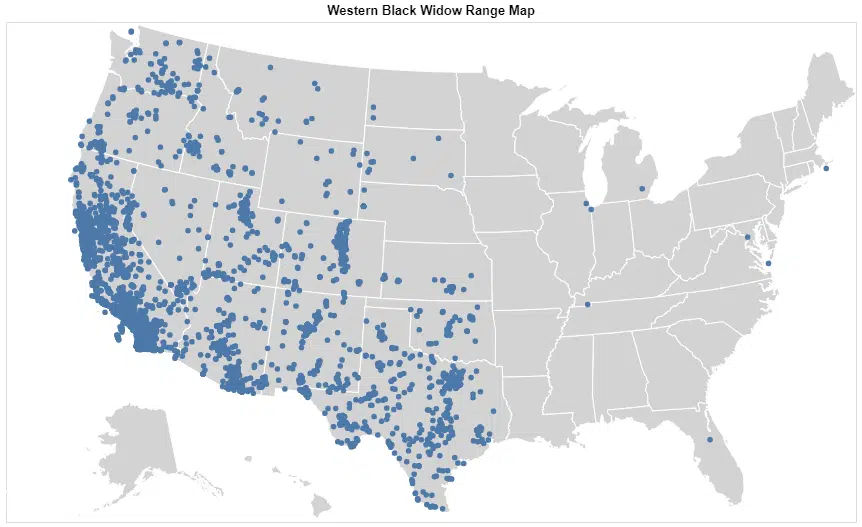
The western black widow (Latrodectus Hesperus) is encountered in the western regions of North America and some parts of Canada. They are common near the US-Canada border.
Northern black widow
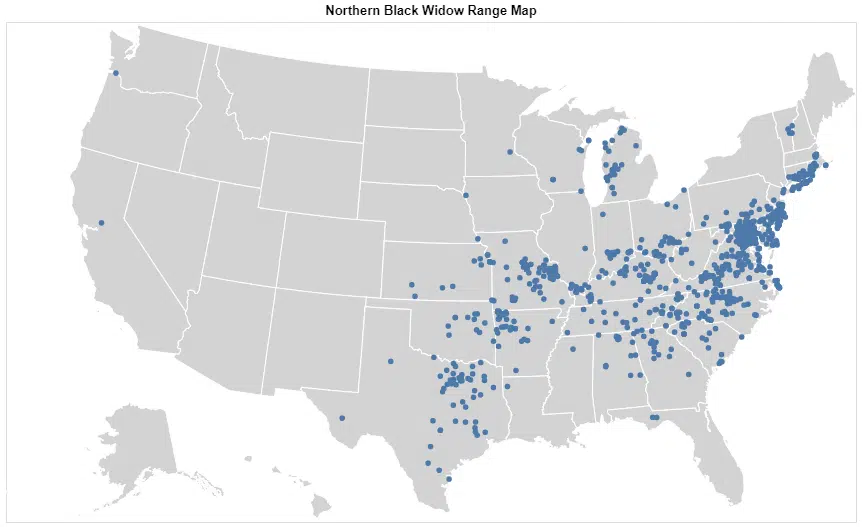
Northern black widows (Latrodectus Variolus) can be found in the eastern parts of the United States from southern Canada down to Florida, along with Kansas, Texas, and Oklahoma. They are also common in the western regions of Michigan.
The female black widow spider has toxic venom, while males are not dangerous and rarely bite.
Both the female and male have hairless and shiny bodies with juveniles starting as brown and turning black with age.
The female black widow is the one you need to know about. They are glossy and black with a red hourglass on their belly.
Males are half the size of the female with females often eating the male after mating.

The black widow spins a web that is often disturbed by humans, which is why there is always a risk of an encounter. Their webs are irregular in shape, often built near rodent holes, under stones, and in outbuildings.
The female black widow spider’s venom is very poisonous and requires immediate medical attention. Often a person is bitten without realizing it, but the pain will start at the bite site and move up the back and stomach within eight to twelve hours. Other symptoms include nausea, sweating, restlessness, tremors, fever, and headaches.
If you think you have been bitten by a black widow, then wash the bite area with soap and water. Do not suck the venom out. Ice the bite site until you get to your doctor. Treatment will speed up recovery, reducing pain and other symptoms associated with the bite.
Brown Recluse vs Black Widow: Similarities
There are not many similarities between the brown recluse and black widow, except that they both create tangled webs.
The black widow will hang upside down in the tangled web and are often encountered when lifting a rock or debris from the ground.
The brown recluse also spins a tangled web, which they use as a retreat. The brown recluse relies on holes made by other creatures as a den, often hiding in cardboard boxes.
Brown Recluse vs Black Widow: 4 Major Differences
There are more differences between these two spiders.
1. Appearance
The first difference is that they are very different in appearance. Black widows are around the size of a dime and are shiny black with a red hourglass and a bulb-shaped abdomen. They are easy to identify.
The brown recluse is larger than a quarter and light brown in color with a dark brown violin on their backs. These spiders are often confused with wolf spiders, but they are not hairy.
2. Habitat
These two spiders may be encountered indoors, but they prefer different habitats.
The brown recluse is an indoor spider, often creating its web in furniture and boxes, while the black widow is an outdoor spider, which may make its way indoors by accident.
3. Eyes
The brown recluse only has six eyes, which are arranged in pairs. The eyes are small and dark.
The black widow has eight eyes which are arranged in two rows of four eyes per row.
4. Venom
The brown recluse and black widow’s venom are very different.
The black widow’s venom is potent enough to take down a small mammal and make an adult human very ill. Symptoms of a black widow bite can range from chills and muscle cramps to vomiting and fever. Some people experience high blood pressure, shortness of breath, and seizures.
Deaths are exceptionally rare due to the fast action of medical teams.
Brown recluse venom, on the other hand, is associated with necrosis. A small percentage of brown recluse bites lead to rotting flesh. Their bites are intense and can last several hours.
The skin reddens and then starts burning and itching. The center of the bite develops a white blister, which can turn into an open wound.
Which One Is More Venomous?
A black widow bite affects the nervous system. It is a very painful bite and everyone reacts differently. Some people experience swelling at the bite site and others experience neurological damage.
Symptoms of a black widow bite can include muscle cramping, chest pain, breathing problems, abdominal pain, and more.
Brown recluse bites, on the other hand, affect the tissues and cells. Their venom is more potent than a rattlesnake, but the recluse spider injects less venom, doing less damage. The bite often goes unnoticed at first, with symptoms occurring within a few hours.
Black widow bites turn red and swell by the second day and after eight days the swelling goes down and the bite opens which means the infection is gone.
The brown recluse, on the other hand, can take weeks to heal with some cases having a severe reaction which includes tissue death and scarring. In some extreme cases, a skin graft may be needed to repair the damage.
If bitten by either of these spiders, you will want to seek immediate medical attention at a hospital that is equipped to deal with spider bites. If you can describe the spider or take it with you.
Note that both of these spiders can be more dangerous to the elderly and children, along with those with a weakened immune system.
Determining which is more venomous, the brown recluse or the black widow is not easy as they are both considered dangerous.
There are no reports of deaths resulting from brown recluse bites, though their bites can result in amputation in severe cases. Black widows, on the other hand, do have a more lethal bite that affects the neurological system and can result in death.
How To Prevent Venomous Spiders
If you have encountered a venomous spider, such as a brown recluse or black widow in your home, it’s understandable you want to get rid of it as safely and quickly as possible.
What to do when you see a venomous spider in your house
If you spot a venomous spider outside the home, then the best is to leave it alone. If the spider needs to be dealt with, then use a spray to kill it.
It is important to be careful to reduce the risk of a bite. Do not try and swat at the spider with something, as you can miss and the spider will drop to the floor and hide, or worse, get onto you or inside your clothing, increasing the risk of a bite.
Clear all obstacles under the spider to ensure it has nowhere to hide. Then spray the spider. Chances are it will drop to the floor where you can strike it. The spray will cause the spider to die, but for peace of mind, clearing all obstacles ensures you don’t lose sight of the spider.
How to prevent venomous spiders from getting to your house?
Prevention is always better than cure when it comes to preventing venomous spiders in the home.
Prevent Black Widows
- Use essential oils such as tea tree oil, peppermint for eucalyptus in an area where you find the spiders in your home. Black widows smell through their feet and by using essential oils, you can keep the spiders away.
- Spray vinegar in areas where you see the spider. Vinegar is acidic and burns the spider on contact. If you see an egg sac, ensure you spray all sides of the sac.
- Vacuum everywhere to ensure you eliminate any webs and food. Removing the web is the best way to keep black widow spiders away. Remember a female black widow will seldom leave her web, so be careful when vacuuming the web to prevent the risk of a bite.
Prevent Brown Recluse
Brown recluse spiders are indoor spiders and move into the home to stay warm and find food.
- Vacuum the home thoroughly to remove webs and egg sacs. Focus on baseboards, bed skirts, under furniture, cabinets, closet, and furniture.
- Use vinegar which can kill the spider on contact. The acidity in vinegar is toxic, spray liberally. Don’t worry the vinegar smell disappears as the vinegar dries.
- Place eucalyptus plants around the home, the brown recluse doesn’t like strong smells. It makes the home smell great and keeps the brown recluse from entering the home. Place on window sills and near doorways.
- Diatomaceous earth is a safe way to keep spiders out. It is a crushed sedimentary rock that you sprinkle where spiders can gain access. This is great for attics, outdoor buildings, and basements.
- Glue traps have proven very effective and cheap. They can be purchased in most home stores and can be placed where you feel a spider may gain entry. One sticky trap can catch some brown recluse spiders.
Summary
The brown recluse and the black widow spiders are very different spiders, both in appearance, their habitat, and the type of bites they give.
Being able to identify the spider and knowing where they are likely to be encountered can reduce the risk of a bite.
Remember that a bite from either of these spiders should be treated as a medical emergency. Always take note of the spider to describe to the medical team.
Further Reading: